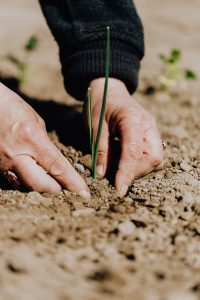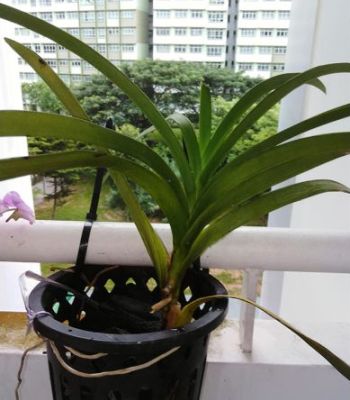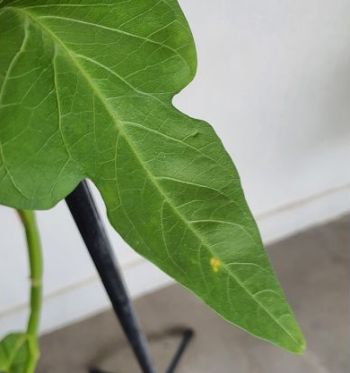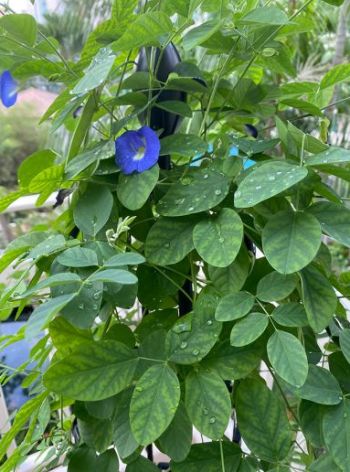Gardening FAQ #27 – What You Need To Know
In this article, we share how to support rapid growth, how to address mealy bug infestation and much more. Let’s go through the common gardening FAQ, problems and solutions you need when growing your plants either indoor and outdoor.
Leafy vegetables need fertiliser weekly to support rapid growth – a common question in gardening FAQ

I grew some plants from seeds and do not know what vegetables they are. After a growth spurt, the plants seem to have stopped growing. I am told they may be lady’s fingers and that I need to provide a trellis to support their further growth.
If you are growing a leafy vegetable from seeds, it is often necessary to apply fertiliser regularly to support your plant’s rapid growth.
Leafy vegetables require weekly applications of organic fertiliser such as processed chicken manure or bone and blood meal powder.
Another reason for slower growth could be due to the lack of sunlight resulting from the recent wet, rainy weather. If you want to grow this better under controlled lighting, you can consider using a grow light. Read up my post on growing lights fixture where I highlight the top 4 things you need to know.
Ensure your plants are not overcrowded as well, as plants in a crowded environment will compete for nutrients, water and sunlight.
The lady’s finger plant grows like a shrub with an upright stem.
You can provide support for your plant by putting a stake next to it and tying the stem to the stake with a figure of eight loop.
Below is a short video showing you how to use banana peel as natural fertilizer for any plants. Try it out today.
Sufficient sunlight needed for orchid to flower
 I have this orchid for two years, but it is not blooming. How can I trigger it to have flowers? What is the name of this orchid?
I have this orchid for two years, but it is not blooming. How can I trigger it to have flowers? What is the name of this orchid?
Without a picture of the flower, it is not possible to identify the orchid plant. However, from the appearance and growth habit of the plant, the orchid is of the vandaceous type and there are numerous hybrids available.
This type of orchid generally requires high amounts of light to thrive and flower – at least six hours of direct sunlight.
As such, insufficient sunlight can be a reason for the lack of flowering in your plant.
The plant is growing in a rather porous charcoal-based media, which dries out quickly. You will probably need to water your plant at least once a day to prevent it from drying out.
The folding, wrinkling and yellowing of leaves could be signs that the plant is lacking water.
Moving the plant to a brighter area should be done in a gradual manner, from lower to higher light levels. If you want to grow this better under controlled lighting, you can consider using a grow light. Read up my post on growing lights fixture where I show you the top 4 things you need to know.
Kangkong could have mealy bug infestation, fungal disease
 The stems of my plant have soft white stains; the leaves have brown spots and some are torn. I tried to wash off the white patches, but they return. What should I do?
The stems of my plant have soft white stains; the leaves have brown spots and some are torn. I tried to wash off the white patches, but they return. What should I do?
The white patches on your kangkong appear to be the waxy secretions produced by mealy bugs. Check for the pests on the stems and leaves.
You may want to also take the plant out from its pot and check for root mealy bugs. These are common in soil-less growing mixes such as the one you are using which has coconut peat in it.
Mealy bugs on the aerial parts of the plant can be eradicated by using a diluted soap solution or environment-friendly pesticides such as summer oil or neem oil. Root mealy bugs are harder to deal with and the infested plant is best discarded.
Growing media from root mealy bug-infested plants should not be reused and pots should be scrubbed clean. Control the population and movement of ants in the growing area as they can move mealy bugs from plant to plant.
Ensure your plant receives sufficient sunlight to promote good health to reduce the severity of pest attacks. If you want to grow this better under controlled lighting, you can consider using a grow light. Read up my post on growing lights fixture where I show you the top 4 things you need to know.
The brown spots on your kangkong leaves could be fungal leaf spots, which can occur if plants are grown in an area with low light and poor air circulation.
Butterfly pea has nutrient deficiency, chilli infested with broad mites
 These plants are grown in my west-facing open balcony, which is in the shade in the morning and receives direct sun in the afternoon. I have four butterfly pea plants growing in a 50cm-wide pot, which contains a larger portion of loamy soil mixed with previous clayey soil at the base. The leaves look pale and unhealthy. What is the cause and what can I do to improve the growing environment? Also, the young leaves of my capsicum plant are curled and the larger leaves have yellow patches at the top. Is this a sign that the plant is unhealthy?
These plants are grown in my west-facing open balcony, which is in the shade in the morning and receives direct sun in the afternoon. I have four butterfly pea plants growing in a 50cm-wide pot, which contains a larger portion of loamy soil mixed with previous clayey soil at the base. The leaves look pale and unhealthy. What is the cause and what can I do to improve the growing environment? Also, the young leaves of my capsicum plant are curled and the larger leaves have yellow patches at the top. Is this a sign that the plant is unhealthy?
Your butterfly pea plant may be suffering from nutrient deficiency as its leaves are chlorotic.
First, the plant could be growing in soil that is of the wrong pH range, where nutrients are locked up and become unavailable. You need to do a soil pH level assessment.
Also, check that you have been regularly giving your plant a fertiliser with chelated trace elements. The soil for your plant should have organic matter and be well-drained, friable and aerated. Soil conditions that are not conducive for healthy root growth will also lead to nutrient uptake issues.
Your chilli plant may be infested with broad mites, which are microscopic in size. The most obvious damage done by such pests will be the deformation of leaves. You can use a sulphur soap solution or lime sulphur insecticide that is sold at selected nurseries to manage the infestation.